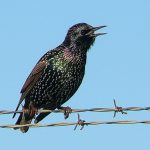 With spring migrations and mating season in full swing, many of us are working on gardening, birdhouse and feeder projects we’ve been day dreaming about all winter long. Unfortunately, with the sunny days come the return of sparrow and starling troubles as well.
With spring migrations and mating season in full swing, many of us are working on gardening, birdhouse and feeder projects we’ve been day dreaming about all winter long. Unfortunately, with the sunny days come the return of sparrow and starling troubles as well.
Many bird lovers have a difficult relationship with these non-native and aggressive birds. Sparrows and starlings both commonly take over birdhouses and feeders meant to attract native cavity-nesting birds and cause no small amount of distress.
Sparrows and starlings are both smart birds that adapt easily to human incursion on the natural world. If you’ve ever seen a bird roosting in your neighborhood hardware store, it’s a good chance it’s one of these two species.
The problem with sparrows and starling
The House Sparrow and European Starling are not Native to The United States, but have adapted well to our environment and cause a threat to global diversity, particularly to more vulnerable native species. These birds will nest almost anywhere, but have a general preference for nesting boxes if they are available. Both species regularly outwit native birds and are extremely aggressive–destroying nests and killing both nestlings and their parents.
Protecting your birdhouse
One of the keys to being a responsible friend of wild birds is to monitor the birdhouses in your yard. A major reasons for monitoring is to help deter aggressive birds and protect nesting sites for more vulnerable species like popular bluebirds. Follow these tips to help deter sparrows and starlings from taking over your birdhouses:
Proper Placement
The easiest way to keep these birds out of your nesting boxes is to place them in areas where House Sparrows and starlings are not present. Keep your boxes away from heavily populated areas and these birds will often not find them at all.
Change your bird food
House sparrows and European Starling generally will not eat safflower, nyjer and nectar. That’s good news if you’re targeting cardinals, finches, hummingbirds and orioles. Use a Nyjer Feeder with small ports and avoid large ports on your bird feeders.
Use protection
Starlings are fairly large birds. Making sure the entrance hole of your birdhouses is less than 1 ½ inches will generally keep them out. For nest boxes with larger holes, add a predator guard to make it smaller.
Time the opening of birdhouses
House Sparrows and European Starling do not migrate. This means they will generally take first right of any birdhouses left open all winter long. Try plugging entrance holes until the first migrating birds begin to return. This works particularly well for Purple Martin houses. However, you’ll need to watch carefully to make sure you don’t unintentionally miss the site seeking phases of the nesting process.
Nest Removal
These “exotic” birds are not protected under the Migratory Bird Treaty Act, so if you do find starlings or sparrows building a nest in one of your birdhouses you can remove the materials. You’ll most likely need to do this daily for up to a week to deter these persistent birds.
Although there are other, more active forms of harassing House Sparrows and European Starlings. We do not recommend these techniques, as they have a high propensity for causing harm.
However you choose to keep your birdhouses and feeders safe from sparrows and starlings, we encourage you to remember that no member of the wild bird species is “evil”, even when they are frustrating. With patience and the techniques above you can keep cavity nesting birds safe without harming more hearty birds.

